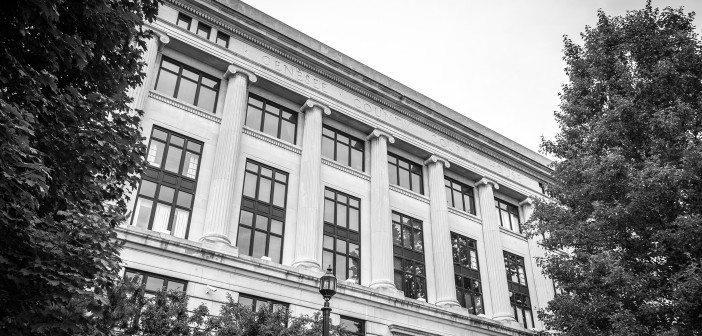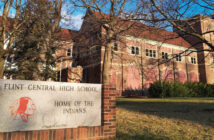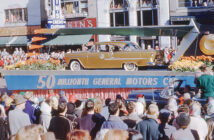This is the first of a three-part series about the historic Genesee County Courthouse – The History, The Re-dedication, and The Murals and Artwork.
Barbara Menear, Court Administrator of the Genesee County Courthouse, is passionate about the history of the courthouse building. She was a longtime attorney in the area and has been the Genesee County Court Administrator for many years. Menear, along with Deputy Court Administrator Janet Patsy, wrote a commemorative publication about the re-dedication events, which were held in 2003 after an addition to the courthouse was completed. Both women put years of hard work into making the courthouse the walking museum that it is today. “The courthouse is the southern anchor of the beautiful Saginaw Street Passageway!” exclaims Menear. “There has been a courthouse on this property since before Michigan became a state.”
History
The land where the courthouse is located has been the site of the center of justice since 1838, according to the publication. There have been five courthouse buildings there in total. The Legislation Council of Michigan Territory recognized Genesee County as a governmental body in 1835. The land was originally owned by the early settler, John Todd. The two-acre parcel was deeded to the county by Wait Beach, who was the owner of the parcel at that time. It was given to the county to be used as a courthouse and public square.
The current building, with its stately presence overlooking Saginaw and Court Street Downtown, was preceded by four others. The first courthouse was built in 1838. The second was built in 1839 and destroyed by fire in 1866. The third courthouse was built in 1867, and remained in use until 1902. In 1904, the fourth courthouse was constructed, but was destroyed by fire in 1920. The current courthouse was built in 1926, and an addition was completed in 2003.
According to the publication, the 1926 courthouse is one of only a small number of neoclassical revival county courthouse buildings in Michigan. The commanding full porches and classic columns are evidence of the neoclassical architectural style. The original jail was built a couple of years later behind the courthouse. Frederick D. Madison of Royal Oak was the architect for both the jail and the courthouse. The project took 16 months to complete at a cost of $710,000. The jail was closed in November 1998 and imploded to make way for the courthouse addition.
The building is a reinforced concrete frame structure with an exterior faced in Indiana limestone. Other building materials include marble wainscoting, wrought iron handrails, American walnut interior appointments, millwork ornamentation of European origin and courtroom murals, which depict local history and legal origins.
Seventh Judicial Court
By an act of the territorial legislature, Genesee was established as a separate county in March of 1835. The first associate judges were Jeremiah B. Smith and Asa Bishop. The first term of court was held February 1837 by the Honorable George Morrel, a Michigan Supreme Court justice. The first case heard was an appeal from the justice court resulting in a judgment for the plaintiff in the amount of $5.63. The case was reversed, and a judgment entered for the defendant in the amount of $16.
Probate Court
The Probate Court was the first to be organized. It was a court of importance to early settlers because the succession of land and property ownership was of great interest. The first case heard was the Last Will of Schuyler V. Brown, presided over in 1836 by the first judge, Samuel Rice. A hearing was set on November 26, 1936 to prove the Will, which was adjourned due to the absence of three witnesses to the Will. On December 5, the witnesses appeared and testified to the validity of the Will. There were no objections, and the first Will was admitted to the Probate Court of Genesee County.
Genesee County’s first clerk was Robert F. State, who was also co-owner of Flint’s first general store. Jesse C. Good was the first clerk in the current courthouse built in 1926. The first prosecuting attorney was Charles Dean Long, elected in 1874. The Genesee County Bar Association was founded in November, 1897 and there were approximately 40 attorney members. The first president of GCBA was George H. Durand.
We’ll take a deeper look at the re-dedication of the courthouse in an upcoming issue.
Source: Re-Dedication Events September 12-14,2003
Commentary Publication written by Barbara Menear and Janet Patsy








